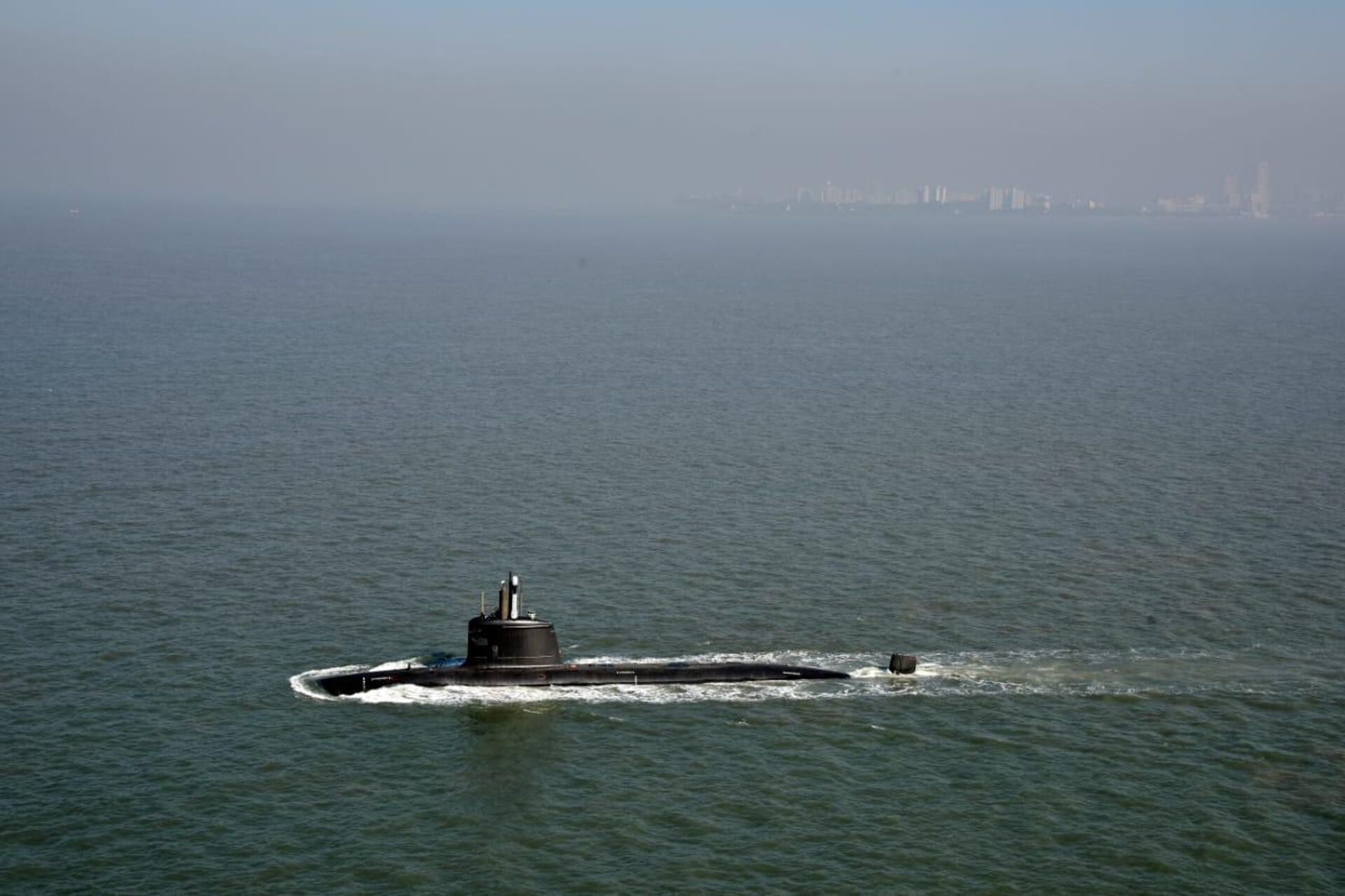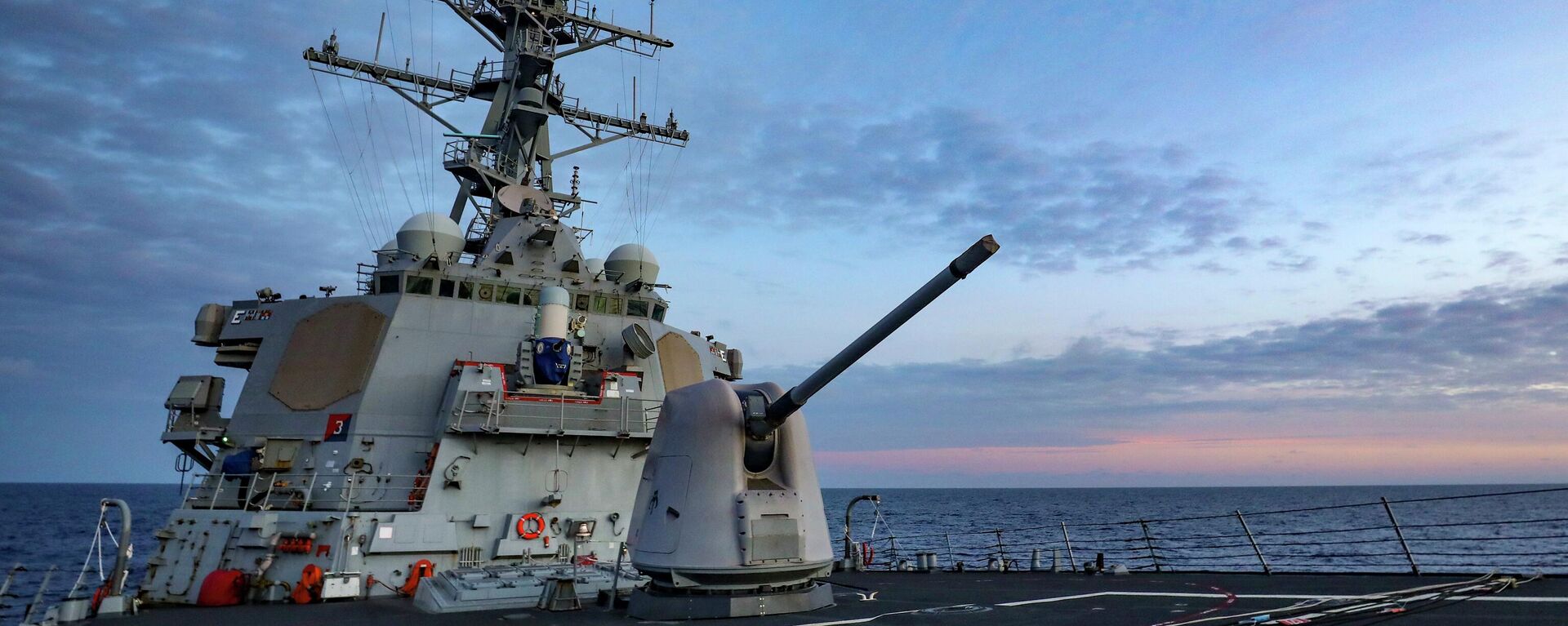https://sputniknews.in/20240418/india-bolstering-nuclear-triad-amid-global-threats-7166817.html
India Bolstering Nuclear Triad Amid Global Threats
India Bolstering Nuclear Triad Amid Global Threats
Sputnik India
The strategic vision of the Indian Navy underscores the prioritization of deploying nuclear triad submarines to ensure the security of the Indian Ocean. In... 18.04.2024, Sputnik India
2024-04-18T20:32+0530
2024-04-18T20:32+0530
2024-04-23T13:31+0530
defenсe news
rajnath singh
indian ocean
us
south china sea
indian navy
government of india
defense sector
ministry of defence (mod)
maritime security
https://cdn1.img.sputniknews.in/img/07e8/02/09/6493306_0:159:3078:1890_1920x0_80_0_0_2dc43e04718dfee1644217f277e0b393.jpg
Amid rising tensions in the Indo-Pacific, the Indian Navy eyes the potential induction of the extended nuclear submarine, known as the S-4.It's expected to be armed with K-4 submarine-launched ballistic missiles, boasting an impressive 3,500-kilometer range.Both the S4 and S-4* submarines are poised to play a crucial role in bolstering India's strategic capabilities as geopolitical dynamics evolve and maritime competition intensifies in the region.India's Nuclear Triad Submarines: A Strategic Milestone & Global Practice"In the Indian Navy's strategic ballistic missile submarine program, the INS Arihant was the first, commissioned in 2016, followed by a similar SSBN and then two larger ones, the S4 and S4*," Cmde Anil Jai Singh (Retd), an Anti-Submarine Warfare (ASW) specialist, told Sputnik India."The second submarine, possibly named S3, might be commissioned or still undergoing trials," he added.According to Singh, "the emergence of the S4 signifies a significant milestone. Known as Sea vectors, these submarines are crucial for a credible second strike capability in nuclear deterrence."He pointed out that "maintaining a fleet of submarines on patrol ensures a credible nuclear deterrence posture, which necessitates having multiple submarines available at all times. This strategic move is not merely a numerical expansion but a logical progression in ensuring a robust nuclear deterrence capability."“India's underwater triad, a cornerstone of its strategic deterrence, underscores the significance of nuclear capabilities within its overall defence strategy. By extending missile ranges, India enhances its ability to target adversaries from safer distances, amplifying its deterrence prowess” Captain Sarabjeet Parmar (Retd), Distinguished Fellow at the United Service Institution of India (USI) told Sputnik India.Strategic Integration of Nuclear & Conventional Capabilities: Enhancing India's Naval DeterrenceThe Captain highlighted that “the capability to target adversaries while operating from waters, where submarines can be adequately protected, represents an advantageous scenario. This approach enables India to pose a credible threat to key strategic assets or targets of adversaries while ensuring the security of its naval forces”.“When considering defence within a strategic posture, it's essential to integrate both nuclear and conventional capabilities. The nuclear capacity influences the structure of conventional forces, as you tailor them with the knowledge of nuclear backup”, Commodore explained.Parmar explained that “ensuring adequate capacity, capability, and numbers is essential for achieving a credible minimum nuclear deterrence. While precise information regarding future nuclear submarine numbers remains undisclosed, there exists a firm dedication to upholding a formidable fleet, especially in light of the security complexities in the Indo-Pacific area”.Securing India's Interests: The Vital Role of Submarines in the Indo-PacificRegarding the Indian Navy's strategic outlook, Singh suggested that “it's imperative for us to concentrate on safeguarding the Indian Ocean and India will not be interested in engaging in conflicts in distant regions such the South China Sea or Taiwan unlike the US”.“Our naval deployments, including routine peacetime operations and exercises, serve to maintain maritime domain awareness and demonstrate our presence. However, venturing into conflicts beyond our primary sphere of influence would be imprudent” according to the Commodore.
https://sputniknews.in/20240406/expansion-of-us-armed-presence-in-indo-pacific-amplifies-regional-tensions-7060146.html
indian ocean
us
south china sea
china
the philippines
taiwan
Sputnik India
feedback.hindi@sputniknews.com
+74956456601
MIA „Rossiya Segodnya“
2024
Swapna Nair
https://cdn1.img.sputniknews.in/img/07e7/09/12/4320104_0:0:681:681_100x100_80_0_0_ca8a7d4d582609272840ffdd1cde7278.jpg
Swapna Nair
https://cdn1.img.sputniknews.in/img/07e7/09/12/4320104_0:0:681:681_100x100_80_0_0_ca8a7d4d582609272840ffdd1cde7278.jpg
News
en_IN
Sputnik India
feedback.hindi@sputniknews.com
+74956456601
MIA „Rossiya Segodnya“
Sputnik India
feedback.hindi@sputniknews.com
+74956456601
MIA „Rossiya Segodnya“
Swapna Nair
https://cdn1.img.sputniknews.in/img/07e7/09/12/4320104_0:0:681:681_100x100_80_0_0_ca8a7d4d582609272840ffdd1cde7278.jpg
indo-pacific, indian navy, nuclear submarine, s4 and s4* submarines, india's strategic capabilities, maritime competition, submarine-launched missiles, ins arihant, cmde anil jai singh (retd), a specialist in anti-submarine warfare (asw), sea vectors, nuclear powers, nuclear deterrence posture, deterrence prowess, captain sarabjeet parmar (retd), distinguished fellow at the united service institution of india (usi), naval forces, nuclear backup, continuous at-sea deterrence (casd), longer-range missiles, nuclear submarine numbers, indo-pacific, south china sea and taiwan strait, us and china, indian ocean, south pacific or the western pacific, indian ocean, external threats, pakistan, nuclear submarines, indian ocean, indian navy's strategic outlook, south china sea or taiwan, us, indian ocean, us and chinese navies, india’s naval capabilities, indian ocean
indo-pacific, indian navy, nuclear submarine, s4 and s4* submarines, india's strategic capabilities, maritime competition, submarine-launched missiles, ins arihant, cmde anil jai singh (retd), a specialist in anti-submarine warfare (asw), sea vectors, nuclear powers, nuclear deterrence posture, deterrence prowess, captain sarabjeet parmar (retd), distinguished fellow at the united service institution of india (usi), naval forces, nuclear backup, continuous at-sea deterrence (casd), longer-range missiles, nuclear submarine numbers, indo-pacific, south china sea and taiwan strait, us and china, indian ocean, south pacific or the western pacific, indian ocean, external threats, pakistan, nuclear submarines, indian ocean, indian navy's strategic outlook, south china sea or taiwan, us, indian ocean, us and chinese navies, india’s naval capabilities, indian ocean
India Bolstering Nuclear Triad Amid Global Threats
20:32 18.04.2024 (Updated: 13:31 23.04.2024) The strategic vision of the Indian Navy underscores the prioritization of deploying nuclear triad submarines to ensure the security of the Indian Ocean. In contrast to the US, India shows no inclination to engage in conflicts in distant regions like the South China Sea or Taiwan, according to experts.
Amid rising tensions in the Indo-Pacific, the Indian Navy eyes the potential induction of the extended nuclear submarine, known as the S-4.
It's expected to be armed with K-4 submarine-launched ballistic missiles, boasting an impressive 3,500-kilometer range.
Both the S4 and S-4* submarines are poised to play a crucial role in bolstering India's strategic capabilities as geopolitical dynamics evolve and maritime competition intensifies in the region.
India's Nuclear Triad Submarines: A Strategic Milestone & Global Practice
"In the Indian Navy's strategic ballistic missile submarine program, the INS Arihant was the first, commissioned in 2016, followed by a similar SSBN and then two larger ones, the S4 and S4*," Cmde Anil Jai Singh (Retd), an Anti-Submarine Warfare (ASW) specialist, told Sputnik India.
"The second submarine, possibly named S3, might be commissioned or still undergoing trials," he added.
According to Singh, "the emergence of the S4 signifies a significant milestone. Known as Sea vectors, these submarines are crucial for a credible second strike capability in nuclear deterrence."
“The presence of submarines at sea constantly ensures the credibility of second-strike capability, a vital aspect of nuclear deterrence.
India's pursuit of these submarines aligns with global practices among nuclear powers” he noted.
He pointed out that "maintaining a fleet of submarines on patrol ensures a credible nuclear deterrence posture, which necessitates having multiple submarines available at all times. This strategic move is not merely a numerical expansion but a logical progression in ensuring a robust nuclear deterrence capability."
“India's underwater triad, a cornerstone of its strategic deterrence, underscores the significance of
nuclear capabilities within its overall defence strategy. By extending missile ranges, India enhances its ability to target adversaries from safer distances, amplifying its deterrence prowess” Captain
Sarabjeet Parmar (Retd), Distinguished Fellow at the United Service Institution of India (USI) told Sputnik India.
Strategic Integration of Nuclear & Conventional Capabilities: Enhancing India's Naval Deterrence
The Captain highlighted that “the capability to target adversaries while operating from waters, where submarines can be adequately protected, represents an advantageous scenario. This approach enables India to pose a credible threat to key strategic assets or targets of adversaries while ensuring the security of its naval forces”.
“When considering defence within a strategic posture, it's essential to integrate both nuclear and conventional capabilities. The
nuclear capacity influences the structure of conventional forces, as you tailor them with the knowledge of nuclear backup”, Commodore explained.
Parmar explained that “ensuring adequate capacity, capability, and numbers is essential for achieving a credible
minimum nuclear deterrence. While precise information regarding future nuclear submarine numbers remains undisclosed, there exists a firm dedication to upholding a formidable fleet, especially in light of the security complexities in the Indo-Pacific area”.
Securing India's Interests: The Vital Role of Submarines in the Indo-Pacific
In the current geopolitical landscape of the Indo-Pacific, Singh mentioned that as the tensions rise in the South China Sea and Taiwan Strait, the true battleground for great power supremacy between the US and China unfolds in the Indian Ocean, not the South Pacific or the Western Pacific.
Regarding the Indian Navy's strategic outlook, Singh suggested that “it's imperative for us to concentrate on safeguarding the Indian Ocean and India will not be interested in engaging in conflicts in distant regions such the South China Sea or Taiwan unlike the US”.
“Our naval deployments, including routine peacetime operations and exercises, serve to maintain maritime domain awareness and demonstrate our presence. However, venturing into conflicts beyond our primary sphere of influence would be imprudent” according to the Commodore.
“India must ensure that we retain the capacity to influence the outcomes of the great power dynamics unfolding in this vital maritime arena. Therefore, it's crucial for us to continue enhancing
India’s naval capabilities to uphold our strategic interests in the Indian Ocean and shape its future according to our objectives” he asserted.





